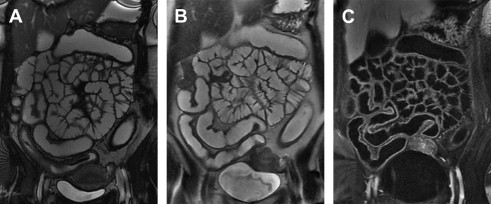Due to advances in technology, magnetic resonance is an increasingly popular method for evaluating the small bowel and colon because of the lack of radiation, wealth of information provided by the images, and growing demand from gastroenterologists, surgeons, and oncologists. Careful attention to proper technique, however, is necessary to obtain high-quality images. Factors that need to be considered for successful magnetic resonance of the bowel include method for administration of oral or rectal contrast, patient positioning, need for antiperistaltic medication, and imaging sequences and planes.
Key points
- •
Magnetic resonance (MR) enterography is imaging of the small bowel following administration of a large volume of oral contrast and is now a recommended method of imaging for patients with inflammatory bowel disease, particularly in young patients.
- •
MR colonography is imaging of the colon following administration of air or fluid via the rectum after the patient has completed a bowel cleansing preparation or fecal tagging.
- •
Antiperistaltic medications are recommended for both MR enterography and colonography to decrease blurring and prevent bowel spasm that may mimic pathologic abnormality.
- •
Rapid imaging sequences are necessary to delineate anatomy, detect polyps or masses, and evaluate bowel wall thickness and signal characteristics.
Introduction
Cross-sectional imaging has become an important and increasingly used method for the assessment of the small bowel and colon. Magnetic resonance (MR) and computed tomographic (CT) imaging can provide information not available endoscopically such as transmural pathologic abnormality and disease in the adjacent tissues and organs. Also, MR and CT enterography and colonography are less invasive than endoscopy and do not have the risks of obstruction and device retention that are associated with capsule endoscopy. Current guidelines recommend CT and MR enterography as the imaging techniques of choice for assessing patients with Crohn disease.
Although CT imaging of the bowel has been preferred in the past over MR because of bowel motion, artifacts, and limits on spatial resolution and coverage, recent advances in MR technology have made it possible to generate high-quality images of the entire bowel, allowing assessment of anatomy, fold patterns, wall thickness, masses, and inflammation. MR enterography and colonography offer several advantages over their CT counterparts. MR imaging is a radiation-free alternative to CT imaging, which is an important feature, given current concerns about radiation exposure from medical imaging. Cumulative radiation is a particular concern in young patients with inflammatory bowel disease who will require a lifetime of imaging as well as for patients who require screening for small bowel (such as Peutz Jeger) or colonic neoplasms. Because of its lack of radiation, multiple postcontrast phases can be performed with little additional risk to the patient, which can allow better characterization of pathologic abnormality. In addition, imaging at multiple time points along with cine imaging can facilitate distinction between peristalsis and stenosis in the bowel and can provide functional information on motility. MR imaging can also provide information that cannot be assessed on CT imaging, such as diffusivity.
The following article presents guidelines for the performance of MR enterography and colonography, including discussions of options for bowel distension, imaging sequences, and need for patient preparation or medication.
Introduction
Cross-sectional imaging has become an important and increasingly used method for the assessment of the small bowel and colon. Magnetic resonance (MR) and computed tomographic (CT) imaging can provide information not available endoscopically such as transmural pathologic abnormality and disease in the adjacent tissues and organs. Also, MR and CT enterography and colonography are less invasive than endoscopy and do not have the risks of obstruction and device retention that are associated with capsule endoscopy. Current guidelines recommend CT and MR enterography as the imaging techniques of choice for assessing patients with Crohn disease.
Although CT imaging of the bowel has been preferred in the past over MR because of bowel motion, artifacts, and limits on spatial resolution and coverage, recent advances in MR technology have made it possible to generate high-quality images of the entire bowel, allowing assessment of anatomy, fold patterns, wall thickness, masses, and inflammation. MR enterography and colonography offer several advantages over their CT counterparts. MR imaging is a radiation-free alternative to CT imaging, which is an important feature, given current concerns about radiation exposure from medical imaging. Cumulative radiation is a particular concern in young patients with inflammatory bowel disease who will require a lifetime of imaging as well as for patients who require screening for small bowel (such as Peutz Jeger) or colonic neoplasms. Because of its lack of radiation, multiple postcontrast phases can be performed with little additional risk to the patient, which can allow better characterization of pathologic abnormality. In addition, imaging at multiple time points along with cine imaging can facilitate distinction between peristalsis and stenosis in the bowel and can provide functional information on motility. MR imaging can also provide information that cannot be assessed on CT imaging, such as diffusivity.
The following article presents guidelines for the performance of MR enterography and colonography, including discussions of options for bowel distension, imaging sequences, and need for patient preparation or medication.
Equipment
To achieve adequate spatial resolution, MR enterography should be performed on a system capable of a field strength of 1.5 T or greater. Increasing availability of 3-T systems will likely result in more MR enterography studies performed at higher field strengths. When transitioning to a 3-T protocol, however, some sequences may need to be modified, particularly T2-weighted imaging, to address increased artifacts and higher specific absorption rates. A phased array coil or combination of phased array coils that can provide coverage of the entire abdomen and pelvis is necessary to image the entire bowel in the coronal plane.
Patient screening
As with other MR techniques, patients should be screened for contraindications to MR imaging or factors that may compromise image quality or the patient’s ability to complete the examination. Patients should be screened for the presence of pacemakers, other devices, or foreign bodies that may malfunction or move due to the scanner’s magnetic field or imaging sequences. Surgical clips in the abdomen and pelvis can result in extensive artifacts based on their composition. Prior MR and CT examinations and their reports should be reviewed for evidence of significant artifact so a decision can be made at the time of scheduling or protocolling as to whether CT or MR imaging is likely to provide the best quality examination for the indication. Artifact related to hip prostheses can pose a particular problem for assessment of the rectum and perianal region. In those patients that MR is preferred or necessary compared with CT, imaging sequences may need to be modified to provide the best information possible.
Claustrophobic or anxious patients need to be reassured that they will have a constant ability to notify the technologist if they need to pause or terminate the examination. Anxiolytics and sedatives should be prescribed with caution, as they may compromise the patient’s ability to comply with breathing instructions.
For examinations that will require intravenous gadolinium contrast, patients should be screened for renal insufficiency or prior allergic reactions to contrast.
Patient preparation
Patient preparation is determined by the need for colonic filling and bowel cleansing. For a small bowel examination, patients are asked to abstain from solid foods for 6 hours before the examination to reduce particulate material in the bowel during the study. Otherwise, patients do not require any additional preparation or dietary restriction for small bowel imaging.
If colonic imaging is desired, patients may be asked to undergo a bowel cleansing preparation similar to that used for colonoscopy, which usually requires the ingestion of a large volume of polyethylene glycol solution beginning the day before the examination. Many patients state the bowel cleanse is the most uncomfortable part of colonic examinations. To increase patient acceptance of colonography, investigators are exploring fecal tagging with agents demonstrating low signal on T1-weighted imaging such as barium or iron. As part of the preparation with fecal tagging, patients may need to avoid fiber-rich foods and foods that contain manganese, such as chocolate, fruits, and nuts, for 2 days before the examination. Manganese appears bright on T1-weighted imaging, which can interfere with the interpretation of the contrast-enhanced images. Current tagging techniques, however, may not perform well enough for widespread clinical use and patient experience with the technique is mixed.
Small bowel contrast
Appropriate selection and administration of oral contrast is critical to achieve adequate and uniform distension of the small bowel. Oral contrast agents can be described as positive (high signal on both T1- and T2-weighted imaging), negative (low on both T1 and T2), or biphasic. Although many agents have been used for MR enterography, biphasic agents are most widely used. The currently preferred agents are low signal on T1-weighted imaging, because high intraluminal signal can obscure abnormal mural enhancement following intravenous contrast administration. Although low intraluminal signal on T2-weighted imaging can improve detection of bowel wall edema, extraluminal fluid, and abscesses, negative contrast agents are more expensive and are not as well tolerated by patients.
Water is a well-tolerated and inexpensive biphasic oral contrast; however, rapid absorption by the small bowel often results in poor distension of the distal ileum. Several biphasic agents containing osmotic (including mannitol, sorbitol, polyethylene glycol) or bulk-forming (methylcellulose, psyllium) additives are currently available. Some studies suggest that osmotic agents may provide better distension than bulk-forming agents. At the author’s institution, they use a low concentration (0.1%) barium sulfate suspension containing sorbitol (VoLumen; E-Z-EM, Westbury, NY) for both CT and MR enterography. Apart from mild diarrhea and cramping experienced by some patients, biphasic agents are typically well-tolerated. Because of the large volume ingested, patients are encouraged to urinate before entering the scanner.
Administration of oral contrast requires both sufficient volume and appropriate timing to achieve uniform distension of the bowel ( Fig. 1 ). Most protocols require 1.5 L to 2 L of oral contrast administered over the course of 40 to 60 minutes. At the author’s institution, the patient is given 450 mL of contrast every 20 minutes beginning 1 hour before the examination for a total of 3 doses. Approximately 450 mL water is given just before entering the magnet. Because the final dose is only for distension of the proximal small bowel and duodenum, hyperosmolar contrast is not necessary. Pediatric patients may receive a smaller dose, typically based on weight.

Although most outpatients can complete the oral contrast protocol, some patients cannot or will not ingest the full dose of contrast. It is encouraged that both the ordering physicians and the radiologist discuss the importance of oral contrast with their patients. For those patients that are unable to complete the entire oral contrast protocol, the examination is performed using the contrast they have been able to drink and will include any limitation of the examination due to inadequate distension in the report. Patients that are acutely ill, particularly inpatients, are screened and often a different examination is recommended in patients who are currently vomiting or are otherwise unable to drink contrast due to pain or altered mental status. If a patient seems to be ill due to an obstruction, however, the procedure will often proceed despite the patient being unable to drink, if a discussion with the referring clinician indicates that acuity of inflammation at the point of obstruction is critical for patient management. As there is often sufficient fluid in the bowel to distend the bowel upstream to the obstruction, oral contrast may not be necessary in these cases. For patients with an acute obstruction, however, the radiologist should contact the ordering physician to see if a CT can provide the necessary information without performing the longer MR enterography.
MR enteroclysis uses an alternative method for bowel distension. MR enteroclysis requires placement of a nasojejunal tube under fluoroscopy, usually an 8-Fr tube because larger tubes are associated with more patient discomfort and may require sedation for the procedure. After confirming the position of the tube distal to the ligament of Treitz, 1 to 2 L of oral contrast is administered manually or with an automated pump. Filling is monitored with intermittent coronal fluid–sensitive imaging to confirm distension of the bowel to the cecum, at which point the infusion is stopped and the MR examination is performed. The decision to perform MR enteroclysis rather than MR enterography is based on several factors, including radiologist experience, indication for the examination, and time available for the examination including tube placement. Currently, MR enteroclysis is performed at fewer institutions than are MR enterography. At centers that perform both examinations, MR enteroclysis is the preferred examination for most small bowel imaging, and MR enterography is reserved for follow-up in patients with known Crohn disease.
Colonic contrast
Agents for distension of the colon are characterized as either dark-lumen or bright-lumen agents based on their appearance on T1-weighted imaging. Bright-lumen techniques require the rectal administration of fluid containing a dilute gadolinium chelate. The primary imaging sequence for bright-lumen colonography is a 3D T1-weighted fat-saturated sequence whereby masses are visible as filling defects. Intravenous contrast is usually not necessary for bright-lumen colonography, as the bright-lumen content limits assessment of enhancement of the wall and any masses. Because the distinction between stool, air, and masses can be difficult with bright-lumen agents, many institutions prefer dark-lumen agents.
Dark-lumen colonography can be performed with either air or water. Air insufflation can be performed with room air or carbon dioxide. Carbon dioxide can be instilled using an automated device similar to what is currently used for CT colonography. The automatic insufflator should remain active during the examination to maintain consistent pressure, as ongoing absorption of carbon dioxide by the colon during the examination may lead to alterations in distension. An advantage of air over fluid for colonic filling is the decreased risk of fecal spillage.
Fluid distension of the colon requires administration of up 2.5 L of warm tap water per rectum, although 1 L may be sufficient in some patients. The fluid is allowed to flow via gravity from a bag positioned about 1 m above the patient, and filling is stopped when either all of the water has been given or the patient begins to feel increasing pressure or discomfort. When performed in conjunction with an MR enterography, the volume tolerated by the patient may be lower because of partial antegrade filling from oral contrast. The rectal tube remains in place until the conclusion of the examination, at which point the fluid can be allowed to drain by gravity back into the bag by placing it on the floor. There is currently conflicting evidence regarding the performance of air versus water for dark-lumen colonography. Although air could result in artifacts on MR imaging, Ajaj and colleagues found no statistical difference in image quality between the 2 methods and contrast-to-noise was thought to be superior on the air examination. In a more recent publication, however, Rodriguez Gomez and colleagues found significantly better distension and less artifacts in subjects with water compared with air distension. The degree of distension during filling for either method can be monitored using intermittent coronal imaging with either gradient echo (for bright lumen) or rapid fluid sensitive sequences (for dark lumen).
Oral contrast has been explored as an alternative to per rectal distension of the colon. The method requires the ingestion of 2 to 2.5 L of contrast, a larger volume than used for small bowel imaging, over the course of 1 to 2 hours before the examination. This method was shown to achieve adequate colonic distension by Bakir and colleagues and may be an alternative method for colonic filling in select patients.
Positioning
The author performs MR of the small bowel with the patient in the prone position when possible because it offers several advantages to supine positioning. Positioning the patient prone decreases the anterior-posterior diameter of the abdomen, allowing for better spatial resolution for any given imaging time when acquiring images in the coronal plane ( Fig. 2 ). Bowel distension is improved in the prone position. Prone positioning also results in compression of the abdomen, allowing separation of the bowel loops. For patients that cannot tolerate the prone position, because of an ostomy or other source of discomfort, the examination can be performed in the supine position.








